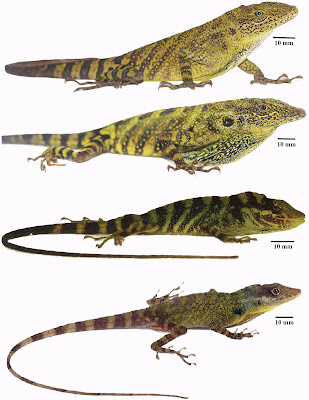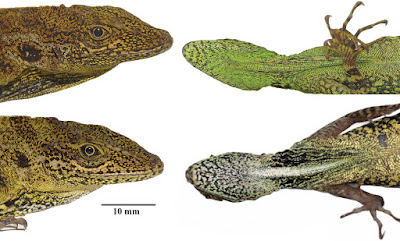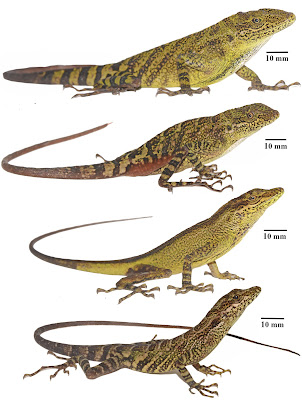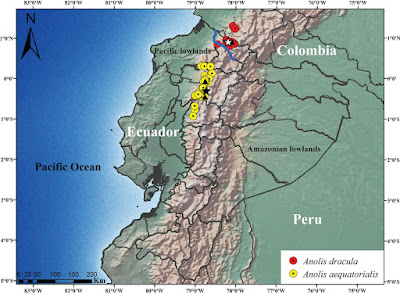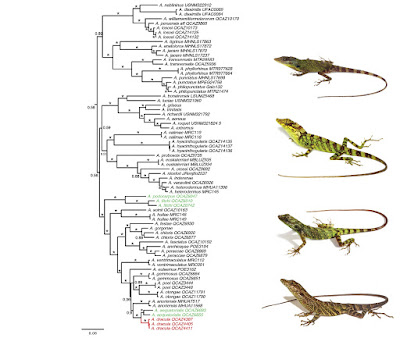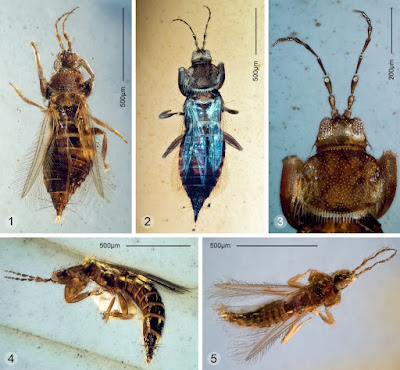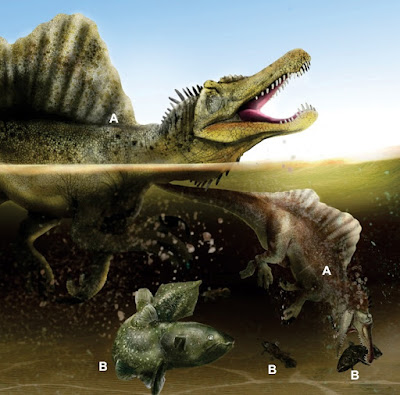[Most Recent Entries] [Calendar View]
Friday, November 2nd, 2018
| Time | Event | ||
| 3:17a | [Herpetology • 2018] Anolis dracula • A New Cryptic Species of Anolis Lizard (Iguanidae, Dactyloinae) from northwestern South America
Abstract A new species of Anolis lizard from the Andean slopes of southwestern Colombia and northwestern Ecuador, from between 1187 and 2353 m in elevation, is described. The new species can be distinguished from other Anolis in squamation, cranial osteology, hemipenial morphology, and nuclear and mitochondrial DNA. The new species is sister to Anolis aequatorialis, and it is suggested that previous records of A. aequatorialis in Colombia correspond to the new species described herein. Keywords: Anolis dracula sp. n., diversity, morphology, phylogeny, Squamata, taxonomy Anolis dracula sp. n. Proposed standard English name: Dracula Anole Proposed standard Spanish name: Anolis dracula Diagnosis: We assign Anolis dracula to the Dactyloa clade within Anolis (Poe 2004, Poe et al. 2017) based on the following combination of characters: sexual size dimorphism; large body with high numbers of lamellae; more than 20 scales across the snout; Alpha type caudal vertebrae; prefrontal bone separated from nasal; lengthened dentary and loss of angular. Anolis dracula is most similar in morphology and coloration to A. aequatorialis (character states in parentheses), but differs from it in the following characters: large and robust hemipenes, 14 mm (4.7 mm; W = 0; p = 0.004), with a well-developed spermatic sulcus (hemipenis small; Figure 8); well-developed parietal crests, bowed outwards and projected laterally (relatively straight parietal crests, without laterally extending edges) (Figure 9); pineal foramen large, oval (rounded and small), and contacting fronto-parietal fissure (pineal foramen not contacting fronto-parietal fissure; Figure 9); rugose (smooth) basioccipital and sphenoccipital tubercles; jugal and squamosal in contact (separated by postorbital; Figure 10); posterior edge of dentary extending over more than a quarter of supra-angular (1/8 the size of supra-angular; Figure 10); dewlap scales cream (green or yellowish green) and in seven (10) rows in males, yellow or turquoise (green or yellowish green) and in five (six) rows in females (Figure 4); edge of dewlap cream (green or yellowish green); dewlap background brown or reddish brown (yellowish green to black), with orange (yellowish green, turquoise or yellowish orange) spots in males; dewlap background reddish brown to black (dark brown to black) in females; throat and chin cream splashed with dark brown (yellowish green); some males exhibit a lateral dark brown ocellus on neck, similar in size to eye (green, turquoise or brown, larger than eye); some females bear a dorsal, longitudinal brown stripe (absent; Figure 3); dark transverse bands on limbs of females weakly defined or absent (limb bands well defined in females, Figs 5, 6); smaller body size, 76.2 ± 8.5 mm SVL, (82.9 ± 9.2 mm; t = 2.96; p = 0.00431); shorter head, 20.6 ± 2.2 mm head length (21.5 ± 1.9; t = 2.18; p = 0.03328); narrower head, 11.1 ± 1.2 mm head width (12.0 ± 1.2 mm; t = 2.99; p = 0.004); shorter forelimbs, 41.4±4.3 mm (45.6 ± 5.4 mm; t = 3.44; p = 0.001); shorter hind limbs, 73.0 ± 7.7 mm (79.1 ± 8.3 mm; t = 2.999; p = 0.004); larger interparietal scale, 1.48 ± 0.25 mm in length (1.22 ± 0.2 mm; t = -4.439; p = -3.85 e-05); narrower tympanum, 2.6 ± 0.3 mm in length (2.8 ± 0.4 mm; t = 2.29; p = 0.027) (Figure 11; Tables 3–4). Etymology: The specific epithet dracula it is a noun in apposition that refers to the Dracula Reserve, located within the distribution of the new species and near its type locality. The Dracula Reserve is an initiative of the EcoMinga Foundation, sponsored by the Orchid Conservation Alliance, Rainforest Trust, University of Basel Botanical Garden, and their individual donors. The Reserve protects an area with a high diversity of orchids of the genus Dracula. Mario H. Yánez-Muñoz, Carolina Reyes-Puig, Juan Pablo Reyes-Puig, Julián A. Velasco, Fernando Ayala-Varela and Omar Torres-Carvajal. 2018. A New Cryptic Species of Anolis Lizard from northwestern South America (Iguanidae, Dactyloinae). ZooKeys. 794: 135-163. DOI: 10.3897/zookeys.794.26936 Resumen: Describimos una nueva especie de Anolis de las estribaciones de los Andes del suroccidente de Colombia y noroccidente de Ecuador, entre los 1187 y 2353 metros de elevación. La nueva especie puede ser distinguida de otros Anolis por caracteres de escamación, osteología craneal, morfología hemipenial, y ADN nuclear y mitocondrial. La nueva especie es hermana de A. aequatorialis, por lo que sugerimos que los registros previos de A. aequatorialis en Colombia corresponden a la nueva especie descrita en este artículo. Palabras clave: Anolis dracula sp. n., diversidad, filogenia, morfología, Squamata, taxonomía | ||
| 9:05a | [PaleoEntomology • 2018] A First Survey of Cretaceous Thrips from Burmese Amber including the Establishment of Rohrthripidae fam. n., A New Family of Tubulifera (Insecta: Thysanoptera); Myanmarothrips pankowskiorum & Rohrthrips burmiticus
Abstract Burmite, a Cretaceous amber coming from the north of Myanmar, is known to preserve a great diversity of fossil arthropods, particularly insects. Many inclusions of different taxa in several insect orders have been well analysed, but this is the first study focussed on the Thysanoptera found in Burmite. In the sub-order Terebrantia, family Merothripidae, Myanmarothrips pankowskiorum gen. n., sp. n. is recognized in various amber samples from a total of 34 females but only one male. In the sub-order Tubulifera, Rohrthrips burmiticus sp. n. is based on a single female with a tubular tenth abdominal segment. This is an exceptionally well-preserved specimen, and details of the mouth parts indicate that the gnathal apparatus of modern Tubulifera was already developed in the Cretaceous. Due to plesiomorphic characters with respect to extant Tubulifera, the genus Rohrthrips is transferred to Rohrthripidae fam. n., and this family is clearly differentiated from extant Phlaeothripidae. Key words: Burmite, Cenomanian, Myanmarothrips gen. n., Merothripidae, new species, new genus, new family, Rohrthripidae fam. n. Manfred R. Ulitzka. 2018. A First Survey of Cretaceous Thrips from Burmese Amber including the Establishment of A New Family of Tubulifera (Insecta: Thysanoptera). Zootaxa. 4486(4); 548–558. DOI: 10.11646/zootaxa.4486.4.8 | ||
| 9:36a | [Paleontology • 2018] Large-sized Theropod Spinosaurus: An Important Component of the Carnivorous Dinosaur Fauna in southern Continents During the Cretaceous
Abstract The Early Cretaceous of North Africa has Spinosaurinae dinosaur remains such as Spinosaurus recorded in Algeria (Guir Basin, Kem Kem beds), Egypt (Bahariya Formation), Morocco (Kem Kem beds), and Tunisia (Ain El Guettar Formation). Until now, three possible Spinosaurus species were identified: Spinosaurus aegyptiacus, Spinosaurus sp. and Spinosaurus “B”. The occurrence of this genus in the Albian-Cenomanian rocks of Africa suggests that the temporal and geographic distribution of these spinosaurines is the largest one among all genera and species of megapredators from the middle Cretaceous of Africa. The fossil record of Spinosaurus from the Albian to the Cenomanian shows a 20 million year persistence of this genus in Gondwanan ecosystems. Keywords: theropod dinosaur, distribution, Early Cretaceous, Africa Remarks: The middle Cretaceous strata of North Africa preserved an important record of the theropod Spinosaurus. Although their fossil remains are usually fragmented, most specimens show diagnostic characters of the genus Spinosaurus that are especially present in their conical and non-serrated teeth. The fossil record of this genus in North Africa shows a restricted geographic distribution between the Albian and the Cenomanian periods. Yet, when we consider their temporal distribution, it suggests that Spinosaurus had a significant geological history of nearly 20 million years, a lifespan unknown for other African megapredators species (e.g., Carcharodontosaurus – 18.5 mya [Candeiro et al., 2018]). The geological evidences indicate that Africa was an island during the main period of occurrence of this genus. The faunal composition of the spinosaurinae that inhabited the eastern coast of Africa is broadly comparable with the Cenomanian fossil records from western Africa, supporting the relative homogeneous composition of the taxon in these areas during this period. Additional studies and future field prospections in other localities could eventually reveal a wider distribution of this genus in other regions of Africa (e.g., Niger, Sudan) or even in western Europe and northern South America. Carlos Roberto A. Candeiro, Lívia Motta Gil and Pedro Ernesto Pontes de Castro. 2018. Large-sized Theropod Spinosaurus: An Important Component of the Carnivorous Dinosaur Fauna in southern Continents During the Cretaceous. Bulletin de la Société Géologique de France. 189 (4-6): 15. DOI: 10.1051/bsgf/2018010 Résumé – Spinosaurus (théropode de grande taille) : une composante importante de la faune de dinosaures carnivores des continents méridionaux au cours du Crétacé. Le Crétacé inférieur d’Afrique du Nord renferme des restes de dinosaures spinosaurinés, tels que Spinosaurus répertorié en Algérie (Bassin du Guir, Kem Kem beds), en Égypte (Formation Bahariya), au Maroc (Kem Kem beds) et en Tunisie (Formation Ain El Guettar). Jusqu’à ce jour, trois espèces de spinosaure sont reconnues : Spinosaurus aegyptiacus, Spinosaurus sp. et Spinosaurus “B”. La présence de ce genre dans les terrains albocénomaniens d’Afrique suggère que la répartition temporelle et géographique de ces spinosaurinés est la plus étendue de tous les genres et espèces de méga-prédateurs du Crétacé moyen d’Afrique. Le registre fossile de Spinosaurus, depuis l’Albien jusqu’au Cénomanien, indique une présence de 20 millions d’années pour ce genre dans les écosystèmes gondwaniens. Mots clés : théropode dinosaure / distribution / Crétacé inférieur / Afrique |
| << Previous Day |
2018/11/02 [Calendar] |
Next Day >> |

